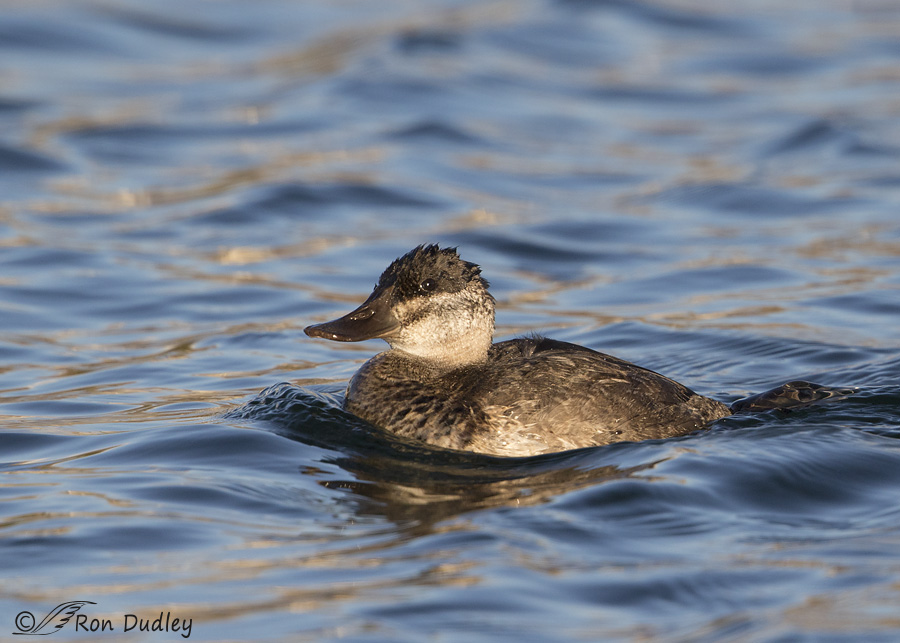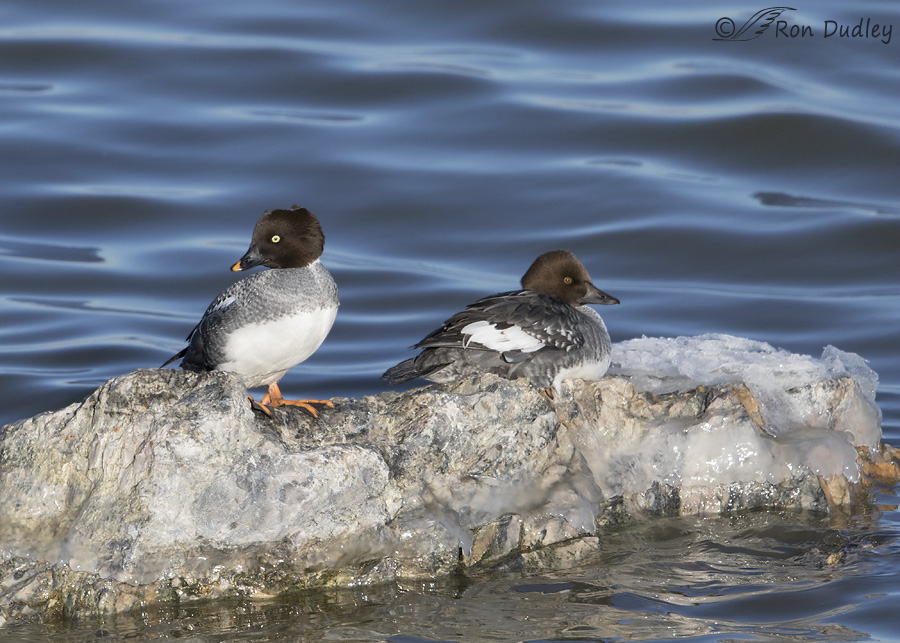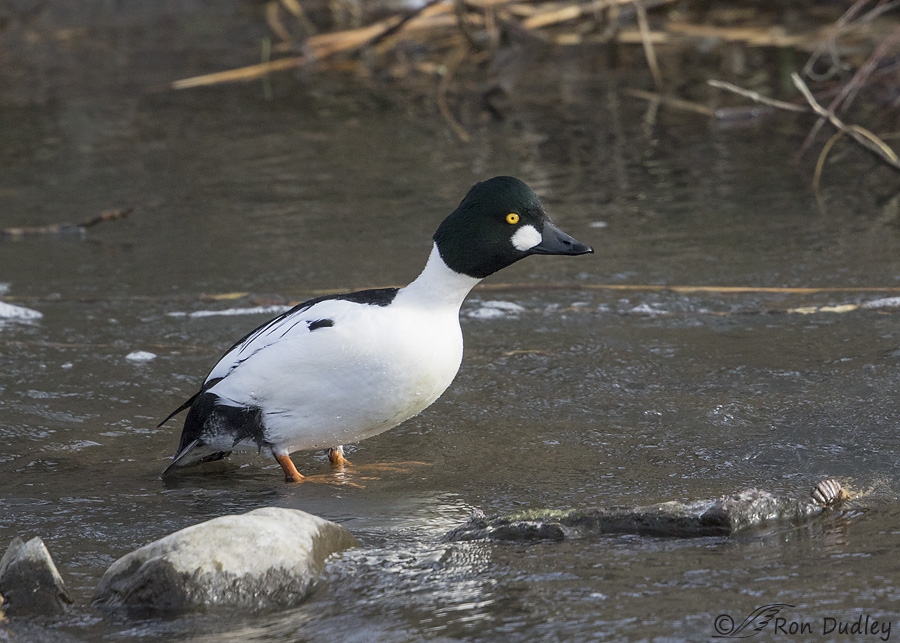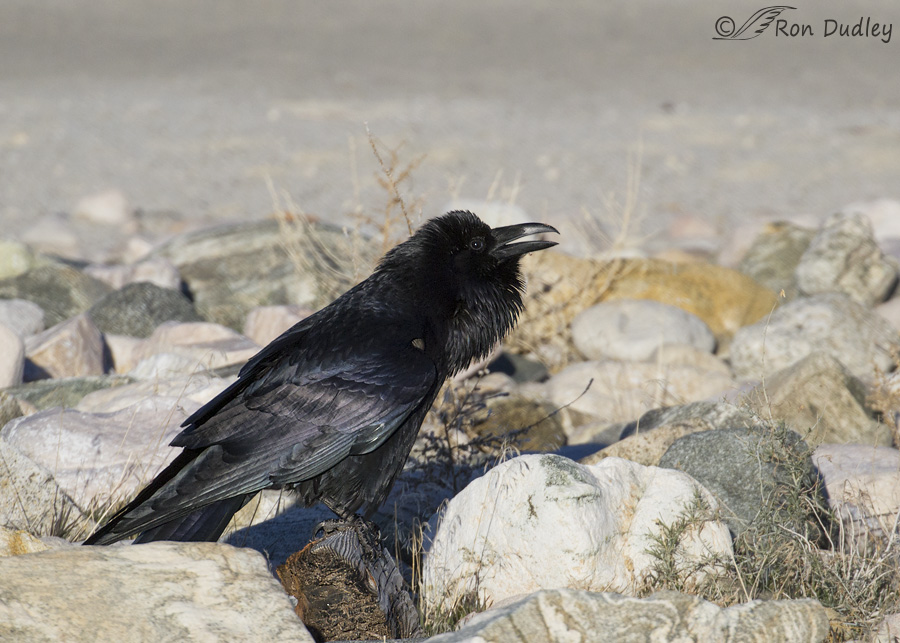Occasionally I like to post a collection of recent bird images – a potpourri of sorts. These are photos that I might not post as stand-alones but collectively they’re a pretty good representation of some of the species now present in northern Utah. Each of these images was taken over the past eleven days.

1/1600, f/6.3, ISO 500, Canon 7D Mark II, Canon EF 500mm f/4L IS II USM + EF 1.4 III Extender, not baited, set up or called in
It’s rare for me to get close enough to a Ruddy Duck for decent photos but this one (an adult female I believe) swam close by me as I was photographing other birds on a pond near my home. Compared to the brightly colored breeding male she’s pretty drab but I always enjoy these perky stiff-tailed ducks of either sex.
The following quote suggests that early naturalists and hunters had some definite opinions about Ruddy Ducks and at least some of them persist to this day:
- “Its intimate habits, its stupidity, its curious nesting customs and ludicrous courtship performance place it in a niche by itself. Even its eggs are unique in appearance and are deposited in a slip-shod, irregular manner that is most extraordinary. Everything about this bird is interesting to the naturalist, but almost nothing about it is interesting to the sportsman.” J. C. Phillips, A Natural History of Ducks, 1926.
Hunters still disdain this species (not necessarily a bad thing…) and they’re considered a pest in Europe where they’ve been introduced but birders and photographers appreciate them at least in part because of the rich colors of the adult male, their highly entertaining courtship display and the unusual aspects of their biology.
 1/3200, f/7.1, ISO 6400, Canon 7D Mark II, Canon EF 500mm f/4L IS II USM + EF 1.4 III Extender, not baited, set up or called in
1/3200, f/7.1, ISO 6400, Canon 7D Mark II, Canon EF 500mm f/4L IS II USM + EF 1.4 III Extender, not baited, set up or called in
Here’s a couple of Common Goldeneyes on a rock jutting out of the Great Salt Lake. The duck on the right is a first winter bird while the other one is an adult female. I think the ice-encrusted rock is almost as interesting as the ducks but I also enjoy the water colors in the background. There were a few males swimming around in the vicinity but on this day I didn’t get any shots I like of them out of the water.

1/1600, f/6.3, ISO 800, Canon 7D Mark II, Canon EF 500mm f/4L IS II USM + EF 1.4 III Extender, not baited, set up or called in
But a few days later I caught this male goldeneye on the Jordan River as it climbed out of the water and onto this submerged rock for just a few seconds before going back to foraging for food in the fast-moving river. I like to photograph ducks out of the water because of the better look it provides of the entire bird. I don’t have many shots of male Common Goldeneyes where they aren’t swimming so I was happy to get this one.

1/4000, f/6.3, ISO 500, Canon 7D, Canon EF 100-400mm f/4.5-5.6L IS II USM @ 400mm, not baited, set up or called in
In some areas (think National Parks and the like) Common Ravens are ridiculously tame but around here I find them very difficult to approach. I can sometimes get close to them in my pickup but they’re gone as soon as I stop to take their photo. This one was an exception and for good reason.
The bird spent several minutes trying to throw a pellet so it was very tolerant of my presence. In fact I was so close that I had to go to my smaller zoom lens. The bird struggled to get the pellet out and evidence of that can be seen in its open beak (it isn’t calling) and the erected throat feathers. Every time it retched I lost the catch light in the eye so I didn’t include any of those photos. The raven never did throw the pellet but it wasn’t for lack of trying and eventually it flew off.
Many folks are surprised to learn that ravens cast pellets but they do. Typically they consist of skeletal remains, fur and feathers but their contents can be highly variable depending on location and typical food items. Here’s an example from a location in Maine (source, Birds of North America Online):
- “In Maine, some pellets consist mostly of cherry pits; mountain cranberry or mountain ash skins and seeds; feathers; or deer, flying squirrel, or rodent hair; a few were all white from quartz gravel, and near a landfill some contained only plastic; 1 consisted completely of a handkerchief “.
Ron


Lovely photos (insert string of superlatives here). You’re really helping with my duck ID skills. Of course, the acid test will be if I can ID them in the field–that’s basically a memory test, but I feel much more confident that I can ID more than the usual mallards. Thank you! Getting to this late, but my fingers/hands aren’t cooperating with much of anything. Sigh!
Neat series of images Ron. The eyes of the Common Goldeneye are mesmerizing. I wonder why they are so intensely bright?
Good question, Ed. Must admit I’d never thought of that…
Love the photographic smorgasbord! The Ruddy Duck video clip was especially interesting. Sort of reminds me of The Far Side cartoon about mating calls. ;). I’ll add my name to the list of those who didn’t know that ravens cast pellets — and how varied those pellets can be.
The ice is beautiful to look at, but not so much to try to drive or walk on. I spent a lot of my winters in IL with a frozen (and sore) caboose! Be safe!
I agree with you about ice, Marty (and enjoyed your sore caboose comment). As I get older one if my fears is to slip on icy cement.
Love your potpourri.
The courtship display is intriguing. Do they have answers about the ‘tail lace’ and the timing of displays yet do you know?
Thank you.
Thank you, EC. No, I haven’t heard anything more about that. I checked BNA and they don’t mention it that I could find.
RON, Just fascinating. Stephen
Thanks, Stephen.
I enjoyed the variation of fowls and information on them. No, I was not aware of Ravens and pellets.
Linda, Don’t feel like the Lone Ranger. A LOT of folks are surprised to learn that ravens cast pellets.
I have always loved the Ruddy Duck, since seeing my first one in YP. I’m glad hunters don’t like them. Perhaps that means they leave them alone?
It’s 2 here right now, with high to be 4. Windchill -20. Think I’ll stay inside.
Thanks again for the photos!
I didn’t think they were hunted very often but I see plenty of recipes for them on the internet. Jane.
Snowing like the dickens here now.
That male goldeneye is gorgeous! I always love seeing your photos, especially since I don’t get to go bird-watching as much as I’d like because of grad school.
Thanks, Annie. Sometimes the practical realities of life interfere with some of the things we’d like to be doing but I hope you can find more time for birds real soon!
I especially enjoy these types of “potpourri” posts. They give a sense of what it’s like in northern Utah.
We get ruddy ducks around here sometimes; The drakes’ plumage is fantastic!
I wonder how the waterfowl out here is doing: in the last month or so we’ve had below freezing temps, high winds, and nonstop, heavy, rain for the past day. All in sunny southern California.. One day this summer it was 117 or so though. When it rains, it rains big, and when it’s hot, it’s hot enough to kill a man. The weather out here in the desert doesn’t do anything halfway!
Levi, at least you’re getting some much-need moisture. I suspect the waterfowl might be in ducky-heaven…
Very grateful for the SoCal soaking we got!
I really like the shot of the Goldeneyes on the icy rock. The ice is definitely interesting. It is also interesting to know that Ravens cast pellets. I watched the Ruddy Duck video, and to me that behavior is just strange – it doesn’t look like courtship behavior (but maybe because I’m not a Ruddy Duck?). We’ll be 15º colder tomorrow, but with the kind of temps you’re talking about, you don’t want to know what colder is here…
Susan, I’ve only seen that Ruddy Duck mating display from a distance but it was definitely entertaining to watch.!
Last night was in the 20’s, colder with the windchill…going up to 58 (!) on Sunday…
That’s quite a rollercoaster ride in temps.
Fun series of photos. They look beautiful on my new computer. The screen resolution is fantastic.
Thanks, April. Quality monitors are a little like top-notch lenses – both can make a huge positive difference in image quality.
Wonderful series on a variety of birds, Ron. Ruddy duck’s mating ritual is interesting. So many details to be noted! -2 and heading down temp wise today………..:(
Ruddy duck’s mating ritual is interesting. So many details to be noted! -2 and heading down temp wise today………..:(
Thank you, Judy.
+ 47 here at the moment with a howling south wind ahead of the front. Highs are forecast to be in the low 20’s tomorrow after the front passes through. Rain turning to snow…